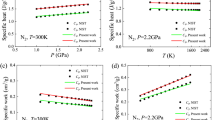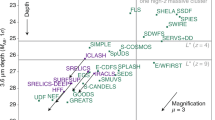Abstract
Reconstructing the density fluctuations in the early Universe that evolved into the distribution of galaxies we see today is a challenge to modern cosmology1. An accurate reconstruction would allow us to test cosmological models by simulating the evolution starting from the reconstructed primordial state and comparing it to observations. Several reconstruction techniques have been proposed2,3,4,5,6,7,8,9, but they all suffer from lack of uniqueness because the velocities needed to produce a unique reconstruction usually are not known. Here we show that reconstruction can be reduced to a well-determined problem of optimization, and present a specific algorithm that provides excellent agreement when tested against data from N-body simulations. By applying our algorithm to the redshift surveys now under way10, we will be able to recover reliably the properties of the primeval fluctuation field of the local Universe, and to determine accurately the peculiar velocities (deviations from the Hubble expansion) and the true positions of many more galaxies than is feasible by any other method.
This is a preview of subscription content, access via your institution
Access options
Subscribe to this journal
Receive 51 print issues and online access
$199.00 per year
only $3.90 per issue
Buy this article
- Purchase on Springer Link
- Instant access to full article PDF
Prices may be subject to local taxes which are calculated during checkout



Similar content being viewed by others
References
Narayanan, V. K. & Croft, R. A. Recovering the primordial density fluctuations: a comparison of methods. Astrophys. J. 515, 471–486 (1999)
Peebles, P. J. E. Tracing galaxy orbits back in time. Astrophys. J. 344, L53–L56 (1989)
Weinberg, D. H. Reconstructing primordial density fluctuations—I. Method. Mon. Not. R. Astron. Soc. 254, 315–342 (1992)
Nusser, A. & Dekel, A. Tracing large-scale fluctuations back in time. Astrophys. J. 391, 443–452 (1992)
Croft, R. A. & Gaztañaga, E. Reconstruction of cosmological density and velocity fields in the Lagrangian Zel'dovich approximation. Mon. Not. R. Astron. Soc. 285, 793–805 (1997)
Nusser, A. & Branchini, E. On the least action principle in cosmology. Mon. Not. R. Astron. Soc. 313, 587–595 (2000)
Goldberg, D. M. & Spergel, D. N. Using perturbative least action to recover cosmological initial conditions. Astrophys. J. 544, 21–29 (2000)
Valentine, H., Saunders, W. & Taylor, A. Reconstructing the IRAS point source catalog redshift survey with a generalized PIZA. Mon. Not. R. Astron. Soc. 319, L13–L17 (2000)
Branchini, E., Eldar, A. & Nusser, A. Peculiar velocity reconstruction with fast action method: tests on mock redshift surveys. Mon. Not. R. Astron. Soc. (submitted); preprint astro-ph/0110618 at 〈http://xxx.lanl.gov〉 (2001)
Frieman, J. A. & Szalay, A. S. Large-scale structure: entering the precision era. Phys. Rep. 333–334, 215–232 (2000)
Bertschinger, E. & Dekel, A. Recovering the full velocity and density fields from large-scale redshift-distance samples. Astrophys. J. 336, L5–L8 (1989)
Zel'dovich, Ya. B. Gravitational instability: an approximate theory for large density perturbations. Astron. Astrophys. 5, 84–89 (1970)
Moutarde, F., Alimi, J.-M., Bouchet, F. R., Pellat, R. & Ramani, A. Precollapse scale invariance in gravitational instability. Astrophys. J. 382, 377–381 (1991)
Buchert, T. Lagrangian theory of gravitational instability of Friedman-Lemaitre cosmologies and the Zel'dovich approximation. Mon. Not. R. Astron. Soc. 254, 729–737 (1992)
Munshi, D., Sahni, V. & Starobinsky, A. Nonlinear approximations to gravitational instability: a comparison in the quasi-linear regime. Astrophys. J. 436, 517–527 (1994)
Catelan, P. Lagrangian dynamics in non-flat universes and non-linear gravitational evolution. Mon. Not. R. Astron. Soc. 276, 115–124 (1995)
Gurbatov, S. & Saichev, A. I. Probability distribution and spectra of potential hydrodynamic turbulence. Radiophys. Quant. Electr. 27, 303–313 (1984)
Shandarin, S. F. & Zel'dovich, Ya. B. The large-scale structure of the universe: turbulence, intermittency, structures in a self-gravitating medium. Rev. Mod. Phys. 61, 185–220 (1989)
Vergassola, M., Dubrulle, B., Frisch, U. & Noullez, A. Burgers' equation, Devil's stair-cases and the mass distribution for large-scale structures. Astron. Astrophys. 289, 325–356 (1994)
Ampère, A.-M. Mémoire concernant l'Application de la Théorie exposée dans le XVIIe Cahier du Journal de l'École Polytechnique, à l'Intégration des Équations aux différentielles partielles du premier et du second ordre. J. École. R. Polytech. 11, 1–188 (1820)
Brenier, Y. Décomposition polaire et réarrangement monotone des champs de vecteurs. C.R. Acad. Sci. 305, 805–808 (1987)
Gangbo, W. & McCann, R. J. The geometry of optimal transportation. Acta Math. 177, 113–161 (1996)
Benamou, J.-D. & Brenier, Y. The optimal time-continuous mass transport problem and its augmented Lagrangian numerical resolution. Numer. Math. 84, 375–393 (2000) also at 〈http://www.inria.fr/rrrt/rr-3356.html〉
Monge, G. Mémoire sur la théorie des déblais et des remblais. Hist. Acad. R. Sci. Paris, 666–704 (1781)
Kantorovich, L. On the translocation of masses. C.R. Acad. Sci. URSS 37, 199–201 (1942)
Rockafellar, R. T. Convex Analysis (Princeton Univ. Press, 1970)
Hénon, M. A mechanical model for the transportation problem. C.R. Acad. Sci. 321, 741–745 (1995)
Balinski, M. L. A competitive (dual) simplex method for the assignment problem. Math. Program. 34, 125–141 (1986)
Couchman, H. M. P., Thomas, P. A. & Pearce, F. R. Hydra: an adaptive-mesh implementation of P3M-SPH. Astrophys. J. 452, 797–813 (1995)
Arnold, V. I. Mathematical Methods of Classical Mechanics (Springer, Berlin, 1978)
Acknowledgements
Special thanks are due to E. Branchini (observational and conceptual aspects), Y. Brenier (mathematical aspects) and M. Hénon (algorithmic aspects and the handing of spatial periodicity and of scatter plots). We also thank J. Bec, H. Frisch, B. Gladman, L. Moscardini, A. Noullez, C. Porciani, M. Rees, E. Spiegel, A. Starobinsky and P. Thomas for comments. This work was supported by the BQR program of Observatoire de la Côte d'Azur, by the TMR program of the European Union (U.F., R.M.), by MIUR (S.M.), by the French Ministry of Education, the McDonnel Foundation, the Russian RFBR and INTAS (A.S.).
Author information
Authors and Affiliations
Corresponding author
Ethics declarations
Competing interests
The authors declare that they have no competing financial interests.
Rights and permissions
About this article
Cite this article
Frisch, U., Matarrese, S., Mohayaee, R. et al. A reconstruction of the initial conditions of the Universe by optimal mass transportation. Nature 417, 260–262 (2002). https://doi.org/10.1038/417260a
Received:
Accepted:
Issue Date:
DOI: https://doi.org/10.1038/417260a
This article is cited by
-
An Efficient Spectral Trust-Region Deflation Method for Multiple Solutions
Journal of Scientific Computing (2023)
-
Convergent Finite Difference Methods for Fully Nonlinear Elliptic Equations in Three Dimensions
Journal of Scientific Computing (2022)
-
Geometry-preserving full-waveform tomography and its application in the Longmen Shan area
Science China Earth Sciences (2022)
-
A review of Lorentzian synthetic theory of timelike Ricci curvature bounds
General Relativity and Gravitation (2022)
-
Entropical Optimal Transport, Schrödinger’s System and Algorithms
Acta Mathematica Scientia (2021)
Comments
By submitting a comment you agree to abide by our Terms and Community Guidelines. If you find something abusive or that does not comply with our terms or guidelines please flag it as inappropriate.



